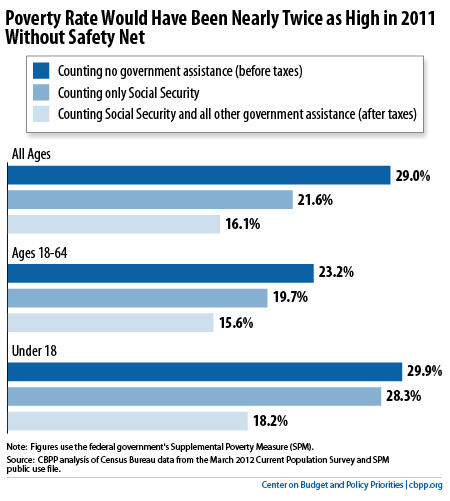BEYOND THE NUMBERS
A House Budget Committee hearing tomorrow will examine the progress we’ve made in fighting poverty over the last 50 years. Extensive research shows that the set of supports the United States has developed to help low-income Americans make ends meet and obtain health care do, in fact, lift millions of people out of poverty, help “make work pay” by supplementing low wages, and enable millions of Americans to receive health care who otherwise could not afford it, as we explain in a new paper.
Federal assistance lifts millions of people, including children, out of poverty and provides access to affordable health care. Public programs lifted 40 million people out of poverty in 2011, including almost 9 million children, according to the Census Bureau’s Supplemental Poverty Measure, which counts non-cash benefits and taxes (see chart).

While Social Security lifted the largest number of people overall out of poverty, the Earned Income Tax Credit (EITC) lifted the largest number of children. Together, the EITC and Child Tax Credit (CTC) lifted 9.4 million people — including nearly 5 million children — out of poverty in 2011. SNAP (Supplemental Nutrition Assistance Program, formerly food stamps) is particularly effective at keeping children out of severe poverty — that is, out of living below half of the poverty line. In 2011, SNAP lifted more children — 1.5 million — above half of the poverty line than any other program.
Similarly, Medicaid provided access to affordable health care to 66 million Americans in 2010. Medicaid and the Children’s Health Insurance Program (CHIP) make children far less likely to be uninsured than adults.
These programs are effective in every state, as we illustrate in our paper through state-by-state data on the number of people — including children — that public programs lifted out of poverty in 2009-2011.
We’ll be back tomorrow with additional findings about how the safety net promotes work and supports low-income working families.
Click here to read the full paper and here and here for the 50-state data.
